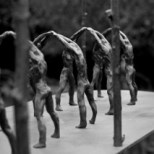
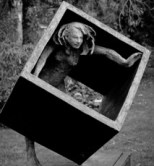
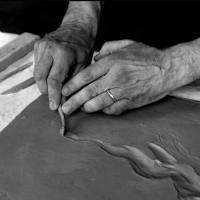
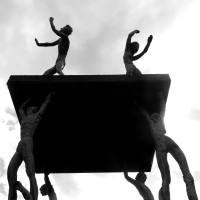
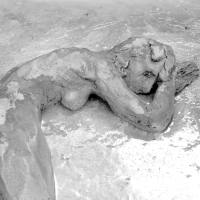
Willy Peeters behoort tot een iets oudere generatie. De generatie die, net als de schilders van toen (Marc Maet, Philip Vandenberg, Fik Van Gestel…), op de conceptuele muur gebotst is. Maar Willy Peeters had en heeft daar veel minder last van gehad dan de schilders. Hij is in zijn nu ruim vijfendertigjarige carrière altijd een beeldhouwer pur sang geweest, zelfbewust en met een positieve ingesteldheid, waarbij hij vooral in brons, maar ook in steen, plaaster, aluminium… werkte en werkt. Hij maakte en maakt kleine, subtiele tot monumentale en krachtige sculpturen, waarvan er vele in het publieke domein prijken, op pleinen en in gebouwen van tal van Belgische, Nederlandse en zelfs Duitse steden en gemeentes.
Willy Peeters' sculpture is not self referential, neither does it refer to the baffling cocktail of 'isms', but to societies underlying values; as if to stress this fact he embraces virtuous and monolithic titles like 'Hope'. Despite -or rather because of - their figurative nature, Peeters sculpts with a high degree of abstraction and suggestion. Even though he develops groups in the nineteenth century tradition, he stops short at adopting hyper-realism. When faced with expectations that he be more photographic in his technique, he resists pressure to standardise his forms. To enhance this non-standardised process, he employs material contrast mainly between bronze and stone. By using rough stone plinths, he transcends the functional and decorative as the stone serves not as a base alone, but plays a dynamic role in the total piece. The stone forms a broad canvass for the moving bronze and often seems to dwarf the figures creating spatial as well as material contrast. In other words he plays with scale to great effect...
The social commitment of Willy Peeters first of all reveals itself through the accessibility of his works, which at the same time is one of the keys to his success. The subjects of his sculptures moreover demonstrate he has an eye for human decisiveness, performance, unremitting labour, solitary diligence, common dedication. As visual artist Peeters has something to offer in the field of aesthetics that seems to fulfil the needs and desires of our society, a society often tormented by insecurity, which reacts anxiously to unexpected changes and sometimes lapses into a state of being adrift, let alone desperation. The sculptor Willy Peeters conveys in bronze what will possibly become the most important assignment of our 21st century: turning the changes that are massively heading towards us and are threatening to overrun us, into actual human progress. This however requires a prototype we may refer to and boast upon, which is exactly what Willy Peeters has to offer.